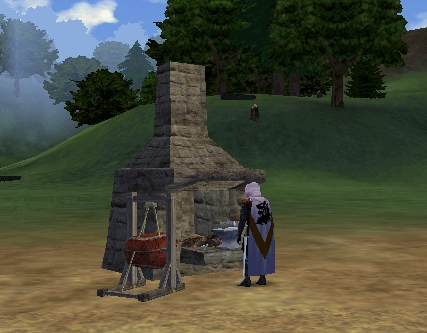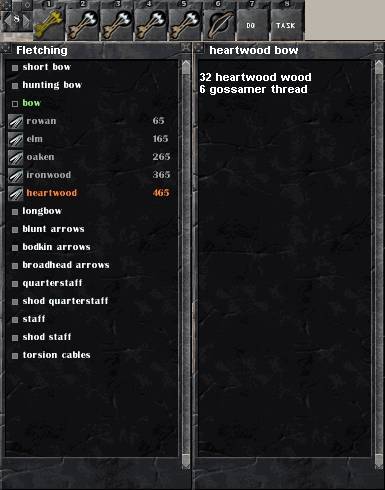 Trade Skills - General Guide
Trade Skills - General Guide

Getting Started
Limitations on the 'other' trade skills
| ||||||||||||||||||||||||||||||||||||||||||||||||||||||||||||

Creating ItemsLimits and numbers are all very nice, but how do you actually make the items? Open the Abilities panel and move to an empty tab on the Quickbar. Click on your primary trade skill in your Abilities panel (may need to scroll down to see it) and drop the resulting icon onto the Quickbar (Fletching skill on slot 1 in the picture). Click on the icon on the Quickbar to open a list of all items you can create with the Skill (panel with 'Fletching' heading in example). Click any of the list items to see a sublist of the material levels of that item currently available to you (notice the listing of different material bows in example). As your skill increases, color-coded entries will appear in these sublists, though you're most likely to find a sublisting under the top list item at this point in your crafting career (Note: Fletching skill was at 450 at time of this picture). Click on the item in the sublist and drop the resulting icon onto another slot on the Quickbar (Heartwood Bow on slot 6 in example). Right-click on either the sublist item, or Quickbar icon to see a bill of materials required to make the item (panel with 'heartwood bow' heading in example). You will need to procure at least the number of listed materials. Buying extra material is a good idea in case of loses, and you can always use it up later on more items. See the associated Materials page for information on which merchants sell the various types of materials. You will be able to find all materials you require in Camelot up to 499 skill level, so it will be quite awhile before you need to trek across the realm in search of materials. While you are running about gathering materials, you will also want to purchase some tools. Though not all tools are absolutely required initially, you will eventually need all 3 (Smithing tool, Planing tool, & Sewing kit) for increasing material skills so you may want to grab them as you visit the various merchants (Armorcrafters & Tailors can safely omit the Planing tool). Now that you've got your shortcut set, tools purchased, and a supply of materials, you're set to begin crafting (maybe). Click the icon on the Quickbar, or hit the corresponding number key to attempt to make the item. Tailors will most likely see a progress bar at this point, Armorcrafters, Weaponcrafters and Fletchers will most likely see a message in the system window that they do not have all the tools required, they must find either a Forge or Lathe. Should you see either message, you will need to stand close to the Forge (near the Armorcraft and Weaponcraft masters) or Lathe (beside Brach Leof) and try again. Once the progress bar is displayed, you are attempting to create the item. When the progress bar has filled, you will receive a message on the success or failure of your attempt. If you are successful, the item will appear in the first available slot in your pack and you may or may not improve your trade and/or material skill(s). If you failed, you run the risk of losing some materials. Regardless of the outcome, the result will be displayed as a System message. That's all there is to it: create shortcut, grab materials, move to Forge/Lathe if required, make item, repeat ad naseum. :)
Improving SkillsGoing back to that statement about color-coded entries, all items in your sublists will be either red, orange, yellow, blue, green or grey. These codes are similar to the monster and item 'cons' in the rest of the game and are a general indication of your chance to succeed at making the item. Most of your crafting career will be spent making blue to orange items, as red items are incredibly difficult (almost impossible) to create, green items, while easy to make, are unlikely to improve your skill, and grey items are so easy to produce, you will not improve skills by doing them. While the cons on the items are a good indicator of your chances of success, it is your actual skill levels versus the items' dificulty which are the true test. Attempting to create items where your primary or material skills are more than 15 points below the requirement will be VERY difficult (impossible with weaponsmithing) and will result in a higher number of failures and potentially, lost materials. With the Heartwood bow in the image above, we see the difficulty on the item is 465. If any of this character's Fletching skill or related material skills (woodworking and clothworking in this case) are 450 (465 - 15) or below, they will have an incredibly hard time attempting to create this item. As your primary trade skill increases, the associated material skills (metalworking, woodworking, etc.) have a tendancy to lag behind. You will need to make trinkets (breadboards, hinges, dolls, bridles, etc), or make items from a secondary trade skill that use similar materials, to keep the material skill levels close to your primary trade skill level. With this 15-point rule in mind, you may wish to hold off doing more commissions or power skill items every 15-20 points of primary skill to work on the material skills. Each time your primary trade skill reaches 99 (99, 199, 299, etc) you will need to return to and speak with (right click) the Order Master. The Order Master will automatically increase your skill to the next hundred mark (100 from 99, 200 from 199, etc.), increase your order rank, and grant you access to the next level of materials. |
||||||||||||||||||||||||||||||||||||||||||||||||||||||||||||
Tips, Tricks and Techniques
|
||||||||||||||||||||||||||||||||||||||||||||||||||||||||||||

